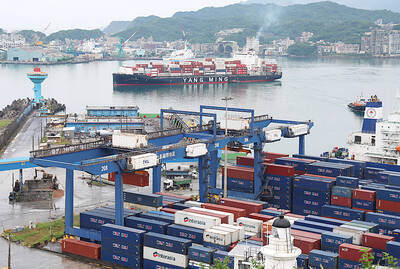Taiwan Semiconductor Manufacturing Co (TSMC, 台積電) yesterday said it is to start high-volume production of its most advanced 20-nanometer (nm) chips next month, a move the chipmaker expects will give its revenue a double-digit boost next year.
The move would also make TSMC the world’s leading contract chipmaker supplying 20nm chips.
Analysts say that mass 20nm chip production could put TSMC in a position to dethrone Samsung Electronics Co as the supplier of Apple Inc’s next-generation A8 chip next year.
TSMC chairman Morris Chang (張忠謀) said in October that 20nm chips would start contributing to the firm's revenue in the second quarter of next year, following the launch of mass production in the first three months of next year.
“The 20nm system-on-a-chip is the most critical ramp-up TSMC has carried out in years. We will start high-volume production of this chip next month,” TSMC president and CEO Mark Liu (劉德音) said in a keynote speech at the company’s annual supply chain management forum in Hsinchu.
Liu said TSMC is on track to ship the chips to its clients on schedule. Thus far, the world’s top contract chipmaker has taped out 20 of the 20nm chips, Liu said in his first public speech after being promoted to co-CEO last month.
The company is expected to ship 165,000 20nm chips to Apple next year, accounting for 10 percent of its revenue that year, Daiwa Capital Markets analyst Eric Chen (陳慧明) said.
Credit Suisse analyst Randy Abrams forecast Apple orders to account for 6.5 percent of TSMC’s overall revenue next year, adding that Qualcomm Inc and MediaTek Inc (聯發科) are to become key clients for TSMC next year.
In the speech, Liu highlighted TSMC’s progress on the 16nm technology front, saying that the company recently initiated the production of 16nm chips and planned to begin mass production within a year.
TSMC is expected to make US$5.4 billion in revenue from advanced 28nm chips this year and the figure could further increase next year, Liu said.
The company, which commands more than 90 percent of the global 28nm chip market, said earlier this year that 28nm chips would be the biggest contributor to revenue this year, since production capacity and revenue are set to triple on an annual basis.
Last quarter, 28nm chips made up 32 percent of TSMC’s revenue of NT$162.58 billion (US$5.48 billion).
As a result, Liu said TSMC’s revenue would show a 17 to 18 percent annual growth this year and grow by double-digit percentage points next year, supported by continuing demand for mobile applications.
That figure would beat the 9 percent annual growth forecast for the contract chipmaking industry, as well as the semiconductor industry’s 5 percent growth.

CHIP RACE: Three years of overbroad export controls drove foreign competitors to pursue their own AI chips, and ‘cost US taxpayers billions of dollars,’ Nvidia said China has figured out the US strategy for allowing it to buy Nvidia Corp’s H200s and is rejecting the artificial intelligence (AI) chip in favor of domestically developed semiconductors, White House AI adviser David Sacks said, citing news reports. US President Donald Trump on Monday said that he would allow shipments of Nvidia’s H200 chips to China, part of an administration effort backed by Sacks to challenge Chinese tech champions such as Huawei Technologies Co (華為) by bringing US competition to their home market. On Friday, Sacks signaled that he was uncertain about whether that approach would work. “They’re rejecting our chips,” Sacks

Taiwan’s exports soared 56 percent year-on-year to an all-time high of US$64.05 billion last month, propelled by surging global demand for artificial intelligence (AI), high-performance computing and cloud service infrastructure, the Ministry of Finance said yesterday. Department of Statistics Director-General Beatrice Tsai (蔡美娜) called the figure an unexpected upside surprise, citing a wave of technology orders from overseas customers alongside the usual year-end shopping season for technology products. Growth is likely to remain strong this month, she said, projecting a 40 percent to 45 percent expansion on an annual basis. The outperformance could prompt the Directorate-General of Budget, Accounting and

NATIONAL SECURITY: Intel’s testing of ACM tools despite US government control ‘highlights egregious gaps in US technology protection policies,’ a former official said Chipmaker Intel Corp has tested chipmaking tools this year from a toolmaker with deep roots in China and two overseas units that were targeted by US sanctions, according to two sources with direct knowledge of the matter. Intel, which fended off calls for its CEO’s resignation from US President Donald Trump in August over his alleged ties to China, got the tools from ACM Research Inc, a Fremont, California-based producer of chipmaking equipment. Two of ACM’s units, based in Shanghai and South Korea, were among a number of firms barred last year from receiving US technology over claims they have

BARRIERS: Gudeng’s chairman said it was unlikely that the US could replicate Taiwan’s science parks in Arizona, given its strict immigration policies and cultural differences Gudeng Precision Industrial Co (家登), which supplies wafer pods to the world’s major semiconductor firms, yesterday said it is in no rush to set up production in the US due to high costs. The company supplies its customers through a warehouse in Arizona jointly operated by TSS Holdings Ltd (德鑫控股), a joint holding of Gudeng and 17 Taiwanese firms in the semiconductor supply chain, including specialty plastic compounds producer Nytex Composites Co (耐特) and automated material handling system supplier Symtek Automation Asia Co (迅得). While the company has long been exploring the feasibility of setting up production in the US to address